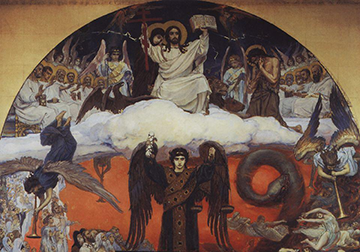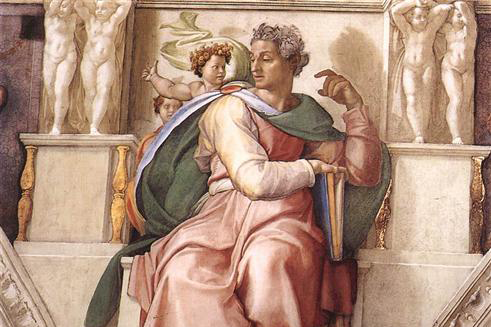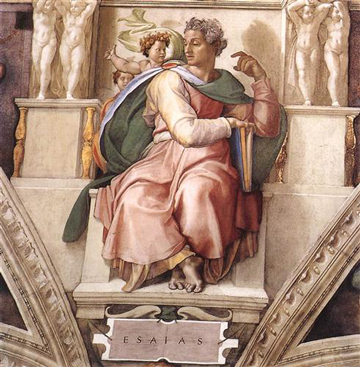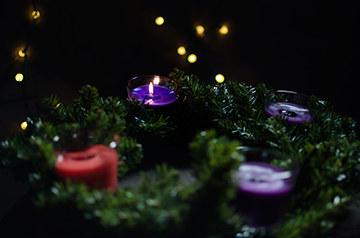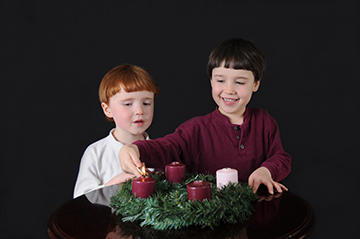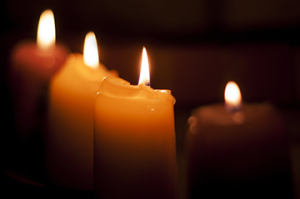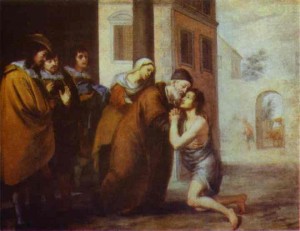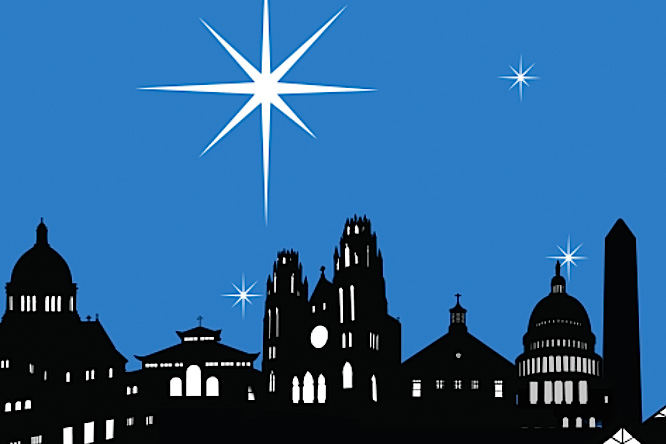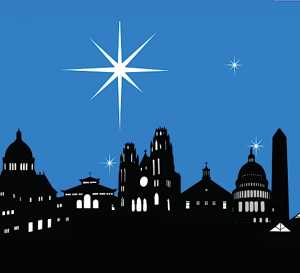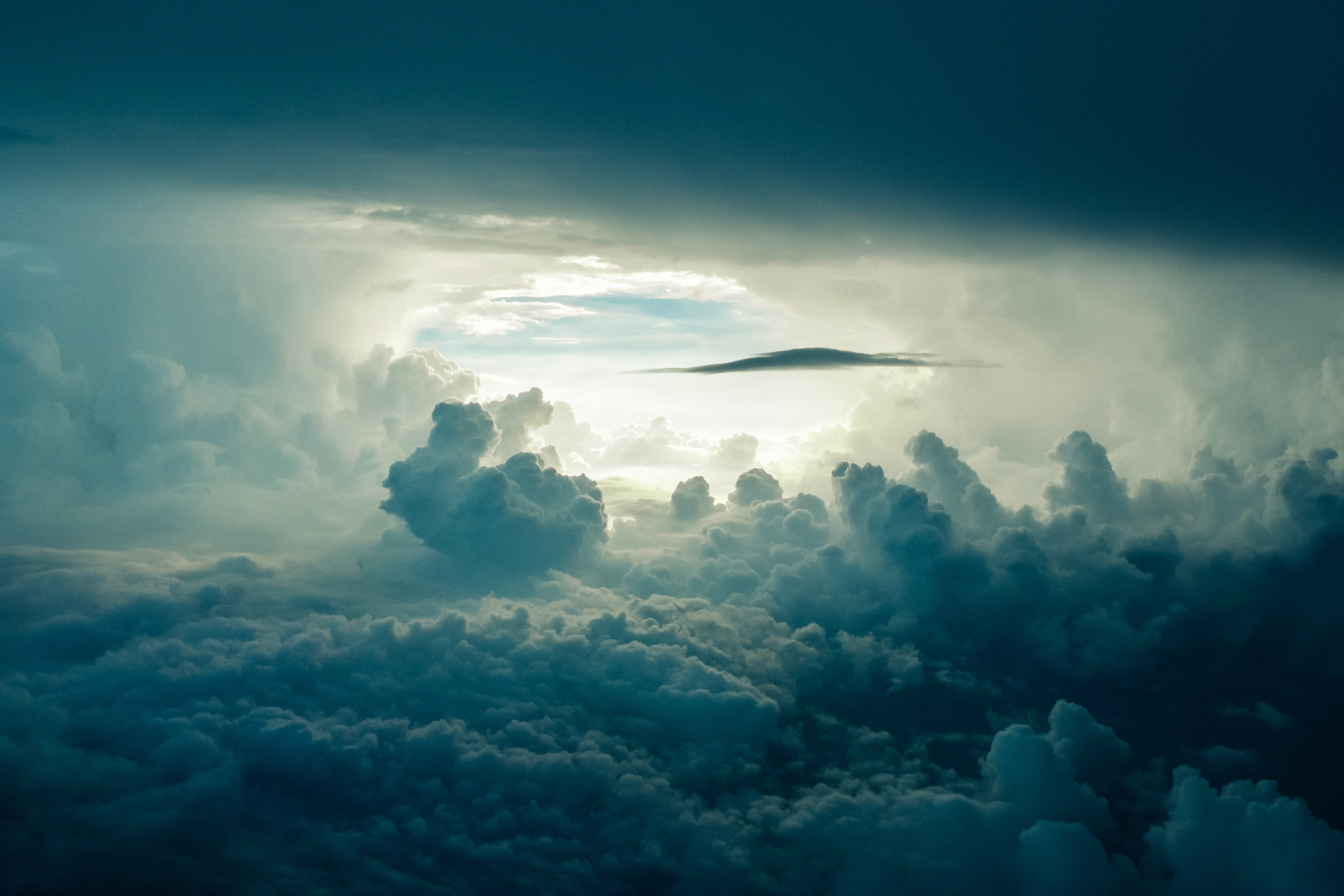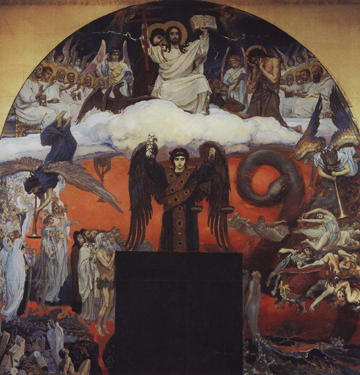 Part of the genius of the African-American spirituals is their ability to treat serious themes such as the final judgment in a creatively compelling manner that steers a middle course between unproductive fear and prideful presumption. Some of them are even playful: “I would not be a sinner. I’ll tell you the reason why. I’m afraid my Lord might call my name and I wouldn’t be ready to die!” Another spiritual says, “Satan wears a hypocrite’s shoe. If you don’t watch, he’ll slip it on you!” Yet another warns with love, “In that great gettin’ up morning, fare you well, fare you well! Oh, fare you well poor sinner, fare you well!”
Part of the genius of the African-American spirituals is their ability to treat serious themes such as the final judgment in a creatively compelling manner that steers a middle course between unproductive fear and prideful presumption. Some of them are even playful: “I would not be a sinner. I’ll tell you the reason why. I’m afraid my Lord might call my name and I wouldn’t be ready to die!” Another spiritual says, “Satan wears a hypocrite’s shoe. If you don’t watch, he’ll slip it on you!” Yet another warns with love, “In that great gettin’ up morning, fare you well, fare you well! Oh, fare you well poor sinner, fare you well!”
Some of the early African-American hymns from the late 19th century also draw heavily on this tradition. One such hymn is “Where Shall I Be When the First Trumpet Sounds?” by Charles P. Jones (1865-1949). The hymn consists in applying the question “Where shall I be?” to a litany of biblically based descriptions of the Second Coming of Jesus, when He will judge the world by fire. Each verse is steeped in rich, biblical tradition. Together, they provide us with a series of good Advent reflections, all rooted in the essential Advent focus of the Second Coming of the Lord Jesus.
When I sing it along with my congregation each Advent, I am reminded of the familiar themes of another masterpiece: the ancient “Dies Irae.” That hymn is also richly biblical and I have written about it on the blog in the past (HERE).
Let’s look at each line of “Where Shall I Be When the First Trumpet Sounds.” I provide some biblical background for each line.
Here is the hymn in toto, followed by a line-by-line analysis, including biblical references and some brief commentary. Since this is a long post I have made it available here as a PDF: Where will you be when the first trumpet sounds. You can listen to the hymn in the video at the bottom of the post.
When judgment day is drawing nigh,
Where shall I be?
When God the works of men shall try,
Where shall I be?
When east and west the fire shall roll,
Where shall I be?
How will it be with my poor soul:
Where shall I be?
Refrain
O where shall I be when the first trumpet sounds,
O where shall I be when it sounds so loud?
When it sounds so loud as to wake up the dead?
O where shall I be when it sounds?
When wicked men His wrath shall see,
Where shall I be?
And to the rocks and mountains flee,
Where shall I be?
When hills and mountains flee away,
Where shall I be?
When all the works of man decay,
Where shall I be?
Refrain
When Heav’n and earth as some great scroll,
Where shall I be?
Shall from God’s angry presence roll,
Where shall I be?
When all the saints redeemed shall stand,
Where shall I be?
Forever blest at God’s right hand,
Where shall I be?
1. When judgment day is drawing nigh, Where shall I be?
A. Now learn the parable from the fig tree: when its branch has already become tender and puts forth its leaves, you know that summer is near; so, you too, when you see all these things, recognize that He is near, right at the door (Matt 24:32-33).
B. Do not grumble … The Judge is standing at the door! (James 5:9)
C. Here I am! I stand at the door and knock (Rev 3:20).
D. If he comes suddenly, do not let him find you sleeping (Mk 13:36).
E. For, in just a little while, he who is coming will come and will not delay (Heb 10:37).
F. While people are saying, “Peace and safety,” destruction will come on them suddenly, as labor pains on a pregnant woman, and they will not escape (1 Thess 5:3).
G. Then the angel I had seen standing on the sea and on the land raised his right hand to heaven. And he swore by him who lives for ever and ever, who created the heavens and all that is in them, the earth and all that is in it, and the sea and all that is in it, and said, “There will be no more delay!” (Rev 10:5-6)
Comment: Judgment day is drawer nearer and nearer for us all. With each beat of our heart the moment edges closer. Are you ready for the Day of Judgment? What are you doing to get ready? The “Dies Irae” says, “Day of wrath and doom impending, Heaven and earth in ashes ending …” Do not delay your conversion to the Lord. The Lord has committed to us the word of reconciliation. Therefore, we are ambassadors for Christ, as though God were making an appeal through us; we beg you on behalf of Christ, be reconciled to God (2 Cor 5:19-20).
2. When God the works of men shall try, Where shall I be?
A. Their work will be shown for what it is, because the Day will bring it to light. It will be revealed with fire, and the fire will test the quality of each person’s work. If what has been built survives, the builder will receive a reward. If it is burned up, the builder will suffer loss but yet will be saved—even though only as one escaping through the flames (1 Cor 3:13-15).
B. For the Son of Man is going to come in his Father’s glory with his angels, and then he will reward each person according to what they have done (Matt 16:27).
C. And I saw the dead, the great and the small, standing before the throne, and books were opened; and another book was opened, which is the book of life; and the dead were judged from the things which were written in the books, according to their deeds (Rev 20:12).
D. God will repay each person according to what they have done. To those who by persistence in doing good seek glory, honor and immortality, he will give eternal life. But for those who are self-seeking and who reject the truth and follow evil, there will be wrath and anger (Rom 2:6-8).
E. But I tell you that everyone will have to give account on the day of judgment for every empty word they have spoken (Matt 12:36).
F. So we make it our goal to please him, whether we are at home in the body or away from it. For we must all appear before the judgment seat of Christ, so that each of us may receive what is due us for the things done while in the body, whether good or bad (2 Cor 5:9-11).
Comment: We will not be saved by our deeds but we will be judged by them, for the veracity of saving faith is made manifest by its work. As Jesus attests, The good man brings out of his good treasure what is good; and the evil man brings out of his evil treasure what is evil (Matt 12:35). Hence, our works shall be tried by God. That is, they shall be judged by the Lord Jesus, to whom we must render an account. The “Dies Irae” says, “Lo the book exactly worded, wherein all hath been recorded, thence shall judgement be awarded.”
3. When east and west the fire shall roll, Where shall I be?
A. Surely the day is coming; it will burn like a furnace. All the arrogant and every evildoer will be stubble, and the day that is coming will set them on fire,” says the Lord Almighty. “Not a root or a branch will be left to them. But for you who revere my name, the sun of righteousness will rise with healing in its rays (Mal 4:1-3).
B. For behold, the LORD is coming forth from His place. He will come down and tread on the high places of the earth. The mountains will melt under Him And the valleys will be split, Like wax before the fire, Like water poured down a steep place (Micah 1:3-4).
C. By the wrath of the LORD Almighty the land will be scorched and the people will be fuel for the fire; they will not spare one another (Isaiah 9:19).
D. For behold, the LORD will come in fire And His chariots like the whirlwind, To render His anger with fury, And His rebuke with flames of fire. For the LORD will execute judgment by fire And by His sword on all flesh, And those slain by the LORD will be many (Is 66:15-16).
E. By the same word the present heavens and earth are reserved for fire, being kept for the day of judgment and destruction of the ungodly … But the day of the Lord will come like a thief. The heavens will disappear with a roar; the elements will be destroyed by fire, and the earth and everything done in it will be laid bare. Since everything will be destroyed in this way, what kind of people ought you to be? You ought to live holy and godly lives as you look forward to the day of God and speed its coming. That day will bring about the destruction of the heavens by fire, and the elements will melt in the heat. (2 Peter 7, 10-12).
Comment: The only way to survive on the day of fire is to be fire yourself. Let God set you on fire with love and bring you up to the temperature of glory. Let God send tongues as of fire to enkindle in you the fire of His love.
4. How will it be with my poor soul: Where shall I be?
A. For it is time for judgment to begin with God’s household; and if it begins with us, what will the outcome be for those who do not obey the gospel of God? “And if it is hard for the righteous to be saved, what will become of the ungodly and the sinner?” So then, those who suffer according to God’s will should commit themselves to their faithful Creator and continue to do good (1 Peter 4:17-19).
Comment: While we can have confidence for the day of salvation, this confidence cannot be in our own ability. It must rest in the grace and mercy of God. We are all poor sinners, beggars before God. The “Dies Irae” says, “What for I fail sinner pleading, who for me be interceding, when the just are mercy needing?”
5. O where shall I be when the first trumpet sounds, O where shall I be when it sounds so loud?
A. Behold, I tell you a mystery; we will not all sleep, but we will all be changed, in a moment, in the twinkling of an eye, at the last trumpet; for the trumpet will sound, and the dead will be raised imperishable, and we will be changed (1 Cor 15:52).
B. Then will appear the sign of the Son of Man in heaven. And then all the peoples of the earth will mourn when they see the Son of Man coming on the clouds of heaven, with power and great glory. And he will send his angels with a loud trumpet call, and they will gather his elect from the four winds, from one end of the heavens to the other (Matt 24:30-31).
C. For the Lord himself will come down from heaven, with a loud command, with the voice of the archangel and with the trumpet call of God, and the dead in Christ will rise first (1 Thess 4:16).
D. The Sovereign Lord will sound the trumpet; he will march in the storms of the south (Zech 9:14).
Comment: The trumpet summons all to judgement, some to glory and others to wrath. But all must come. This is an appointment that all must keep! The “Dies Irae” says, “Wondrous sound the trumpet flingeth, Through earth’s sepulchers it ringeth, all before the throne it bringeth.”
6. When it sounds so loud as to wake up the dead? O where shall I be when it sounds?
A. And there will be a time of distress such as never occurred since there was a nation until that time; and at that time your people, everyone who is found written in the book, will be rescued. Many of those who sleep in the dust of the ground will awake, these to everlasting life, but the others to disgrace and everlasting contempt (Dan 12:1-2).
B. And [The Father] He gave Him authority to execute judgment, because He is the Son of Man. Do not marvel at this; for an hour is coming, in which all who are in the tombs will hear His voice, and will come forth; those who did the good deeds to a resurrection of life, those who committed the evil deeds to a resurrection of judgment (Jn 5:27-29).
C. For the trumpet will sound, the dead will be raised imperishable, and we will be changed (1 Cor 15:52).
Comment: Where will you be? Will you be with the righteous or with the wicked, with the Saint or the aints? Everyone will rise, but to entirely different realities. Where shall I be?
7. When wicked men His wrath shall see, Where shall I be?
A. “Surely the day is coming; it will burn like a furnace. All the arrogant and every evildoer will be stubble, and the day that is coming will set them on fire,” says the LORD Almighty. “Not a root or a branch will be left to them” (Mal 4:1).
B. By the same word the present heavens and earth are reserved for fire, being kept for the day of judgment and destruction of the ungodly (2 Peter 3:7).
C. The wrath of God is being revealed from heaven against all the godlessness and wickedness of people, who suppress the truth by their wickedness (Rom 1:18).
D. You formerly walked according to the course of this world, according to the prince of the power of the air, of the spirit that is now working in the sons of disobedience. Among them we too all formerly lived in the lusts of our flesh, indulging the desires of the flesh and of the mind, and were by nature children of wrath, even as the rest (Eph 2:2-3).
E. You turned to God from idols to serve a living and true God, 10and to wait for His Son from heaven, whom He raised from the dead, that is Jesus, who rescues us from the wrath to come (1 Thess 1:9-10).
Comment: Are you getting this? The Day of Judgment is going to be bad for the wicked. They will experience God’s wrath. And what is God’s wrath? It is our experience of the total incompatibility of our sin in the presence of God’s holiness. It is like fire and water coming together. They cannot coexist; there is a fundamental conflict and one has to give way. So it is with sin in the presence of God—no can do. Only Jesus can give us the capacity to stand before God’s utter sanctity. Only Jesus can rescue us from the coming wrath. The “Dies Irae” says, “When the wicked are confounded, Doomed to flames of woe unbounded: Call me with thy saints surrounded.”
8. And to the rocks and mountains flee, Where shall I be? When hills and mountains flee away, Where shall I be?
A. As the soldiers led him away, they seized Simon from Cyrene, who was on his way in from the country, and put the cross on him and made him carry it behind Jesus. A large number of people followed him, including women who mourned and wailed for him. Jesus turned and said to them, “Daughters of Jerusalem, do not weep for me; weep for yourselves and for your children. For the time will come when you will say, ‘Blessed are the childless women, the wombs that never bore and the breasts that never nursed!’ Then they will say to the mountains, ‘Fall on us! and to the hills, ‘Cover us!’ For if people do these things when the tree is green, what will happen when it is dry?” (Luke 23:26-31)
B. Men will go into caves of the rocks And into holes of the ground Before the terror of the LORD And the splendor of His majesty, When He arises to make the earth tremble (Is 2:19).
C. Then the kings of the earth and the great men and the commanders and the rich and the strong and every slave and free man hid themselves in the caves and among the rocks of the mountains; and they said to the mountains and to the rocks, “Fall on us and hide us from the presence of Him who sits on the throne, and from the wrath of the Lamb; for the great day of their wrath has come, and who is able to stand?” (Rev 6:15-17)
Comment: You can’t run from God because He’s already there. There will be no escape, no postponing the Day of Judgment.
9. When all the works of man decay, Where shall I be?
A. Each man’s work will be shown for what it is, because the Day will bring it to light. It will be revealed with fire, and the fire will test the quality of each person’s work. If what has been built survives, the builder will receive a reward. If it is burned up, the builder will suffer loss but yet will be saved—even though only as one escaping through the flames (1 Cor 3:13-15).
B. But the day of the Lord will come like a thief, in which the heavens will pass away with a roar and the elements will be destroyed with intense heat, and the earth and its works will be burned up (2 Peter 3:10).
C. Jesus came out from the temple and was going away when His disciples came up to point out the temple buildings to Him. And He said to them, “Do you not see all these things? Truly I say to you, not one stone here will be left upon another, which will not be torn down” (Matt 24:2).
Comment: All things of man shall pass away, including all our works. Only what we do for Christ will last. Jesus says, You did not choose me, but I chose you and appointed you so that you might go and bear fruit—fruit that will last—and so that whatever you ask in my name the Father will give you (Jn 15:16). Only what you do for Christ will last. All other works will decay.
10. When Heav’n and earth as some great scroll, Where shall I be? Shall from God’s angry presence roll, Where shall I be?
A. Come near, you nations, and listen; pay attention, you peoples! Let the earth hear, and all that is in it, the world, and all that comes out of it! The Lord is angry with all nations; his wrath is on all their armies … the mountains will be soaked with their blood. All the stars in the sky will be dissolved and the heavens rolled up like a scroll; all the starry host will fall like withered leaves (Isaiah 34:1-4).
B. The fourth angel sounded his trumpet, and a third of the sun was struck, a third of the moon, and a third of the stars, so that a third of them turned dark. A third of the day was without light, and also a third of the night (Rev 8:12).
Comment: The “Dies Irae” says, “Death is struck and nature quaking, All creation is awaking, To its judge and answer making.” Come on now, if even the stars are struck and must answer, who are we to make light of judgement?
11. When all the saints redeemed shall stand, Where shall I be? Forever blest at God’s right hand, Where shall I be?
A. But who can endure the day of His coming? And who can stand when He appears? For He is like a refiner’s fire and like fullers’ soap. He will sit as a smelter and purifier of silver, and He will purify the sons of Levi and refine them like gold and silver, so that they may present to the LORD offerings in righteousness (Mal 3:2).
B. Wherefore … having done all to stand, Stand therefore, having your loins girt about with truth, and having on the breastplate of righteousness; And your feet shod with the preparation of the gospel of peace; Above all, taking the shield of faith, wherewith ye shall be able to quench all the fiery darts of the wicked. And take the helmet of salvation, and the sword of the Spirit, which is the word of God: praying always with all prayer and supplication in the Spirit, and watching thereunto with all perseverance and supplication for all saints (Ephesians 6:10-18).
C. “When the Son of Man comes in his glory, and all the angels with him, he will sit on his glorious throne. All the nations will be gathered before him, and he will separate the people one from another as a shepherd separates the sheep from the goats. He will put the sheep on his right and the goats on his left. Then the King will say to those on his right, ‘Come, you who are blessed by my Father; take your inheritance, the kingdom prepared for you since the creation of the world’” (Matt 25:31-33).
Comment: The Dies Irae says, “With thy sheep a place provide me, From the goats afar divide me, To thy right hand do thou guide me. When the wicked are confounded, Doomed to flames of woe unbounded: Call me with thy saints surrounded.”
Yes, it’s quite a song, so rich in biblical allusion! Like the “Dies Irae,” it references many scriptures quite vividly and creatively. And like so many of the spirituals, it is able to combine them in ways that are almost celebratory. The hymn is usually sung in an upbeat manner; in my parish we clap hands as we sing.
At the end of the day the question remains: Where shall I be? Will I be among the righteous in glory, or among the sinful and unrepentant in Hell? Where, poor sinners that we are, shall you and I be? Thanks be to God for His grace and mercy, which help us to stand a chance.
But as with all offers of God, grace and mercy are accessed only through repentance.
This song, like the more ancient “Dies Irae,” could not be more clear: we are hastening to the Day of Judgment, a day about which to be sober and ready. Are you ready? Where shall you be when the first trumpet sounds?
Here is a performance of the song:

